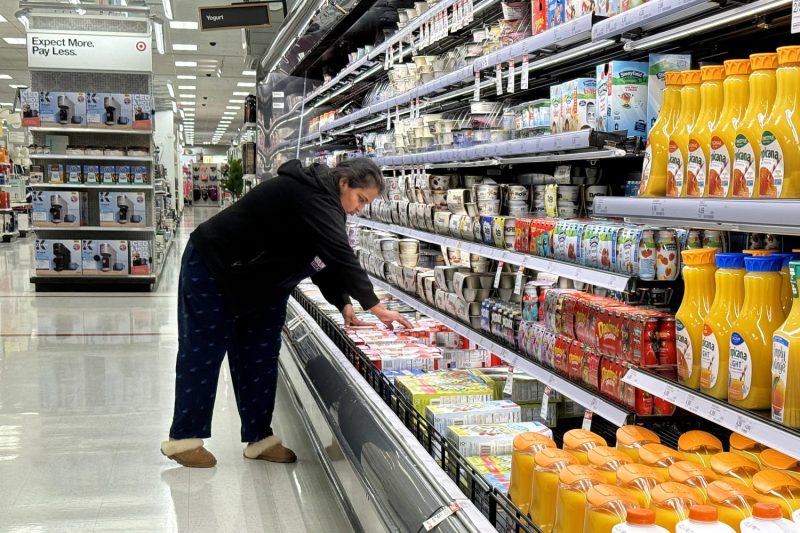
Trump tariffs, tax cuts and interest rates likely to fuel inflation, Wall Street and economists agree
Former President Donald Trump is building a second-term economic agenda that analysts say could reheat the very inflation that he has slammed President Joe Biden for creating.
“I call it a ring around the country. We have a ring around the country,” Trump said in a Time magazine interview released Tuesday, referring to aggressive tariffs he has promised to impose in a second term. “I also don’t believe that the costs will go up that much.”
The presumptive Republican presidential nominee has repeatedly pledged to hike tariffs, cut taxes and encourage cheap money policy if he wins the November election.
Yet economists and Wall Street analysts agree that these plans would likely drive consumer prices higher.
Trump has outright dismissed this idea: “I don’t believe it’ll be inflation. I think it’ll be lack of loss for our country,” he said in the Time interview.
Trump has pledged to raise tariffs by 10% on imports across the board, and push them even higher — to between 60% and 100% — for China and Mexico.
He also wants to extend his first-term tax cuts, which raised deficits when they were first implemented and are due to expire in 2025.
“I will make the Trump Cuts permanent … and we will cut your taxes even more,” Trump said at a February rally in South Carolina.
Plus, Trump has signaled his intent to replace Federal Reserve Chairman Jerome Powell and then to pressure the next Fed chair to lower interest rates. Trump allies have also been working on plans to force the Fed to consult Trump on interest rate decisions, according to a Wall Street Journal report.
Analysts view these proposals as threats to inflation’s rocky road back down to the commonly accepted ideal level of around 2%.
“A second Trump term could bring higher tariffs, attempts to weaken the dollar, even higher deficits, deportation of illegal immigrants, and other policies that could put upward pressure on inflation,” Piper Sandler analysts wrote last week.
“Most of the major policy initiatives being suggested by Donald Trump’s campaign would be inflationary,” Paul Ashworth, Capital Economics’ chief North America economist wrote Monday. “Whether it’s narrowing the trade deficit via tariffs or a dollar devaluation, curbing immigration or, now we learn, compromising the Fed’s independence.”
When it comes to tariffs, Wall Street analysts note that businesses pass on higher import costs to their customers by raising prices.
Trump flatly rejected that idea in the Time interview. “A lot of people say, ‘Oh, that’s gonna be a tax on us.’ I don’t believe that. I think it’s a tax on the country that’s [exporting] it.”
Trump’s tariff policies “would be a significant escalation to existing trade policy, and they would further increase costs for U.S. importers, place upward pressure on inflation and potentially strengthen the U.S. dollar,” Wells Fargo analysts wrote in a report from early April.
But that inflationary impact “could be partially absorbed in the near term,” the Wells Fargo analysts added, explaining that many suppliers have started to diversify their inventory away from “tariff-exposed product.”
The Trump-era tariffs on China that nearly started a trade war had only a “marginal” effect on the economy, according to the Wells Fargo report: “The surge in consumer price inflation is primarily attributed to the pandemic’s disruptions rather than the trade war’s tariffs.”
Reached for comment, the Trump campaign said, “under President Trump, inflation was non-existent, gasoline was cheap, groceries were affordable, and the American Dream was alive and well.”
Despite the inflationary threat posed by core elements of Trump’s agenda, polling has consistently found that voters trust Trump more than they trust Biden to bring down the cost of living and manage inflation.
In part, voters’ nostalgia for Trump’s economy is a byproduct of the scars that post-pandemic inflation left them with.
In January 2017, when Trump took office, the consumer price index, a key inflation metric, hung at an annual rate of 2.51%. That number dipped over the course of his administration, and by the time Biden entered the Oval Office, the 12-month inflation rate was at 1.40%.
By the summer of 2022, year-over-year CPI had soared to roughly 9%, driven primarily by the collision of pent-up consumer demand with a snarled global supply chain that could not deliver products fast enough. CPI has since cooled, to 3.48% in March of this year.
But that inflation whiplash over the past five years appears to have left many voters with a bitter memory of the Biden economy.
It has also catapulted a data point that is usually only tracked by economists into the front of voters’ minds, and introduced it to a new generation.
The last time inflation was above 9% was in 1981. The only Americans who were over 18 years old in 1981, and thereby most likely to directly feel the soaring prices, are people who, today, are 61 and above. For everyone else, this kind of inflation has no precedent in their adult lives.
Biden has faced an uphill climb to persuade voters that they are better off thanks to his economic accomplishments, including low unemployment, sustained GDP growth and historic clean energy investments.
In recent months, Biden has also taken a more aggressive stance on potential trade restrictions on China. Earlier in April, Biden said he wants to triple tariffs on imported Chinese steel and aluminum.
But while Biden makes his economic case to voters, Trump has capitalized on the fraught economic data of the past several months to lambast his opponent and the Fed.
“INFLATION is BACK—and RAGING!” Trump wrote in a Truth Social post earlier in April. “The Fed will never be able to credibly lower interest rates, because they want to protect the worst President in the history of the Untied States!”
It was unclear what the former president meant by this, especially given that Powell, a lifelong Republican, was appointed by Trump.
